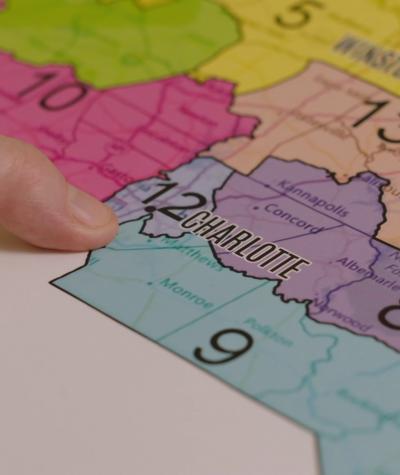To understand gerrymandering, it is first important to understand how states draw political district maps.
Every 10 years, on the years that end in zero, Americans participate in the Census. Data from the Census is then used to create congressional and state legislative district maps. It is also used for redistricting at the local level, including county boards, city councils and school districts.
The redistricting process is supposed to reflect changes in the population so that every person can have the opportunity for equitable representation in our government. It plays a vital role in determining whether we will be able to make our voices heard on the issues that matter most to our communities.
But in several states, the politicians who are responsible for drawing maps often create new districts that would enable themselves and members of their own political party to win elections more easily. The manipulation of the mapmaking process for personal gain is called gerrymandering, and gerrymandered districts hurt voters, especially Black and brown voters, by making it harder for them to elect their preferred candidates.
Q: Where did the term gerrymandering come from?
A: Gerrymandering is practically as old as the country itself. The first recorded instance occurred in the late 1780s when James Madison was nearly gerrymandered out of a congressional seat.
However, the word did not become part of the lexicon until a few decades later. In 1812, Elbridge Gerry, a Founding Father who was the governor of Massachusetts at the time, approved a state Senate map with a salamander-shaped district that benefitted his own party, the Democratic-Republicans.
In response, the Boston Gazette published a “Gerry-mander” cartoon criticizing this district. Soon, the cartoon was reprinted by several newspapers that favored the opposing Federalist Party. Thus, the manipulation of district lines became known as gerrymandering.
Q: Historically, what are the main ways that political parties have gerrymandered maps to benefit themselves?
A: There are generally four ways that politicians gerrymander maps to disadvantage voters and instead advantage themselves or their political party. These are:
- Malapportionment – drawing districts with deliberate differences in population, which causes constituents in highly populous districts to have effectively less voting strength (drawn to disadvantage the opposite political party or voters of color) than their counterparts in more sparsely populated districts (drawn to advantage voters of the same political party as the map drawer).
- Racial voting dilution –redistricting plans that minimize or cancel the voting strength of Black and brown voters.
- Partisan gerrymandering – creating political maps that enable a political party to gain a systemic advantage for itself.
- Racial Gerrymandering – sorting voters into districts with a predominant focus on race. The U.S. Supreme Court has found that an excessive focus on race in drawing districts offends the Fourteenth Amendment to the Constitution unless there is sufficient justification, such as compliance with the Voting Rights Act (VRA).
Q: How exactly do politicians and political parties employ various tools to create gerrymandered maps?
A: The two most common methods that are used to create gerrymandered maps are cracking and packing.
Cracking is the practice of dividing a group’s supporters among multiple districts so that they fall short of a full majority in each district. Packing is the practice of concentrating a group’s support heavily in a few districts so that the group wins significantly fewer districts than it would have had its supporters been spread out more evenly.
Q: Why are election experts particularly worried about the harmful impacts that gerrymandered maps approved now could have on voters in the coming decade?
A: Due to the COVID-19 pandemic and other factors, the release of the census data needed to complete the redistricting process was delayed, creating worries that politicians could rush to finalize gerrymandered maps without sufficient transparency or opportunities for public input.
In addition, it will also be the first redistricting cycle that has taken place since several Supreme Court decisions that have removed safeguards against racial and partisan gerrymandering, including in the cases Shelby County v. Holder and Rucho v. Common Cause.
The 2020 Census revealed significant population growth among people of color in the U.S. since 2010. With these changing demographics, power struggles over district maps are bound to increase as politicians fight to retain power.
Further, in recent redistricting cycles, the accuracy of voter databases and mapping software has skyrocketed, leading to a trend of increasingly skewed maps in the states where politicians control district line drawing.
Map drawers can use precise voting data and mapping software to pinpoint down to the census blocks level, deciding to include or exclude areas based on whether it will benefit them in future elections.
Q: How does gerrymandering contribute to other political issues we are currently facing in our democracy?
A: Gerrymandering changes incentives so that politicians are less likely to engage in consensus-building within their districts and more likely to channel the passion of base voters in primaries, contributing to extremism in our political system. Gerrymandering even played a role in the Jan. 6, 2021, attack on the Capitol.
Q: Are there solutions that would enable us to combat gerrymandering?
A: Yes, there are. We've outlined them in greater detail here. But, simply put: Congress should pass legislation banning partisan gerrymandering and adopting independent redistricting commissions nationwide. Campaign Legal Center already endorses two bills that would achieve fairer maps: The Freedom to Vote Act gives federal courts the ability to determine when a partisan gerrymander has gone too far. And the John Lewis Voting Rights Advancement Act would ensure the already-illegal practice of racial gerrymandering is more effectively policed. We also have long supported independent redistricting commissions, which you can learn more about here. At the end of the day, what we need is a national effort to prevent gerrymandering across the country once and for all.
